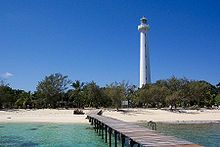Amédée lighthouse
 |
|
|
New Caledonia
|
|
| Location | Nouméa, New Caledonia |
|---|---|
| Coordinates | 22°28′38″S 166°28′05″E / 22.477330°S 166.467952°ECoordinates: 22°28′38″S 166°28′05″E / 22.477330°S 166.467952°E |
| Year first constructed | 1865 |
| Automated | 1985 |
| Construction | cast iron tower |
| Tower shape | 16-side tapered prism tower with balcony and lantern |
| Markings / pattern | white tower and lantern |
| Height | 56 metres (184 ft) |
| Focal height | 52 metres (171 ft) |
| Original lens | 250 mm lens |
| Light source | solar power |
| Range | 20 nautical miles (37 km; 23 mi) |
| Characteristic | Fl (2) W 15s. |
| Admiralty number | K4802.1 |
| NGA number | 3644 |
| ARLHS number | NCA-001 |
|
[]
|
|
The Amédée lighthouse (French: le phare Amédée) is an iron lighthouse located on Amédée Island, 24 km away from Nouméa, New Caledonia.
The metal components were made by Rigolet in North-East Paris in 1862 and the tower was constructed in Paris as a demonstration. It was then disassembled into pieces weighing a total of 387,953 kilos and transported along the River Seine to the port of Le Havre for its voyage to New Caledonia. At 56 metres tall (247 steps), it is one of the tallest lighthouses in the world and it was the first metallic lighthouse constructed in France. The foundation stone was laid on 18 January 1865 and it was first lit on 15 November 1865, the saint day of the Empress Eugénie, wife of Napoleon III. Its light signals the entrance to the passage of Boulari, one of only three natural passages in the reef surrounding New Caledonia. On the other side of the world, the Roches-Douvres Light in the English Channel is the twin brother of the Amédée lighthouse. It is now a very popular tourist attraction.
In 1859, the acting Commandant of New Caledonia, Jean-Marie Saisset, asked the government in Paris to build a lighthouse to help ships navigating into the port of Nouméa (then Fort-de-France), particularly as the colony had been chosen as a new destination for French convicts.
Taking into account the lack of stonemasons and other skilled workers in the colony, the French lighthouse commission proposed a pre-fabricated iron design, a relatively new method first used in 1841 by the British consulting engineer, Alexander Gordon, for the Morant Point Lighthouse in Jamaica. The Minister for the Navy and the Colonies, Prosper de Chasseloup-Laubat, approved the project and appointed Léonce Reynaud who had already designed many lighthouses, and who had also designed the original Gare du Nord in Paris.
Reynaud followed Gordon in making the pieces out of puddled iron, and in keeping the lighthouse narrow enough to be constructed without scaffolding. He innovated by keeping the internal structure independent of the external envelope: this was intended as protection against corrosion in the humid tropical environment for which he was designing. The plans were exhibited at the 1862 International Exhibition in London.
...
Wikipedia

